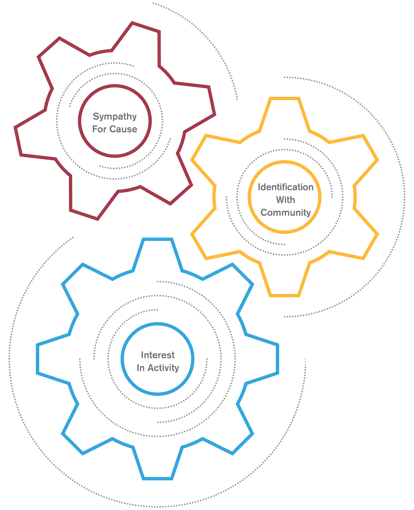3 Questions Your P2P Engagement Strategy Is Missing
It's Spring, which means the snow has melted, the birds are chirping, the flower buds are peeking out in bloom, and Dance Marathon season has officially commenced. As soon as I flipped my calendar to March, my Instagram and Twitter feeds were flooded with photos of college students dressed in luminescent colors and fanny-packs, caught in the camera's flash mid-dance move.
While these events themselves are usually 24 hours of consecutive dancing, many more hours go into a participant's preparation for the event. Take, for example, Dance Blue, University of Kentucky's 24-hour dance marathon. Marathon rules require that each participant fundraises a certain dollar amount beforehand and then dances for the entire 24 hours. Outside of the marathon itself, participants are encouraged to join one of eight planning committees and attend "mini-marathons" that are put on throughout the year leading up to the main event.
To some, that transaction – a year-long fundraising venture, countless nights spent planning, and 24 uninterrupted hours of dancing – seems laughable, but for many UK college students, it’s the formula for a fantastic weekend.
Individuals decide whether or not to participate in a dance marathon, a book club, a political campaign, or your nonprofit fundraising event based on a variety of factors. Sure, the activity is important (and often of paramount consideration in the event fundraising space), but it’s not the only factor at play. Think about the most important decisions you’ve made in your life – your first job, for example. Before you signed the contract, you didn’t simply consider the activity you’d be performing in your new role; you also considered the personalities and demographics of your coworkers, the company culture, and the proximity of the office to your favorite food truck. Similarly, many UK students likely wouldn't join Dance Blue if not for their friends investing in the event as well.
Understanding the multifactorial formula that drives a person to choose participation in a fundraising event over inaction is the first step in attracting high-potential, passionate individuals that will then turn to their networks and say, “Do this dance marathon/5K/walk with me and raise awareness and funds for [insert your cause].” Fortunately, the complex decision-making process can be boiled down to three highly influential, interlocking forces, or participant drivers.

The three questions driving your supporters’ decision to participate (or not) in your peer-to-peer event are:
1. Do I care?
Do your constituents feel sympathy for your cause, and, if so, how are you connecting them to it?
2. Do I belong?
Do your constituents feel a sense of belonging or identification to your organization’s network of supporters?
3. Would I do it?
Are your constituents interested and able to participate in your event?
In our experience as consultants, we’ve gotten under the hood of many of the nation’s largest P2P programs to evaluate why their participation and fundraising numbers didn’t meet goal. Sometimes, the problem lies within the composition of one of the three participant drivers: communications aren’t written or directed toward the right people, the event didn’t create a communal environment, or the activity simply didn’t interest the target audience (which is why simply imitating other events is always a bad idea). Other times, however, programs stall because the three drivers aren’t interlocking and aligning with one another appropriately.
To understand the integral role each driver plays and the importance of aligning them, we at Plenty have created a framework referred to as the Participant Gears. Each gear focuses on a critical area of your program constituents consider during their decision process. Each gear has the power to propel or stall your event growth. Evaluating your peer-to-peer program through the lens of the Participant Gears framework will allow you to consider the importance that each plays in your constituents’ decision-making process while not forgetting its impact on the other factors.
The Participant Gears framework is fully unpacked in our e-book, which provides detailed information on understanding the significance of cause, community, and activity to your core constituents, how to evaluate your peer-to-peer program’s optimization of each, and what to do when the one or more of the gears aren’t interlocking appropriately.
Each of these gears has the capacity to work for or against the purpose and prosperity of your peer-to-peer fundraising event or campaign. Together, they present the important questions your constituents are considering as they choose whether or not to participate (and fundraise) for you. If your gears are all turning in the same direction, they can create incredible growth momentum. If one is out of sync — or worse, rotating in the opposite direction — your campaign might deteriorate or fail altogether. Just as each human being works on multiple dimensions because they have multiple interests, there are multiple, equal forces driving your constituents to participate in your peer-to-peer program. If you asked us which of the gears is the most important, our answer would be, "Yes."
Share this
You May Also Like
These Related Stories

Three Reasons People Participate In Your Peer-to-Peer Event



Comments (1)